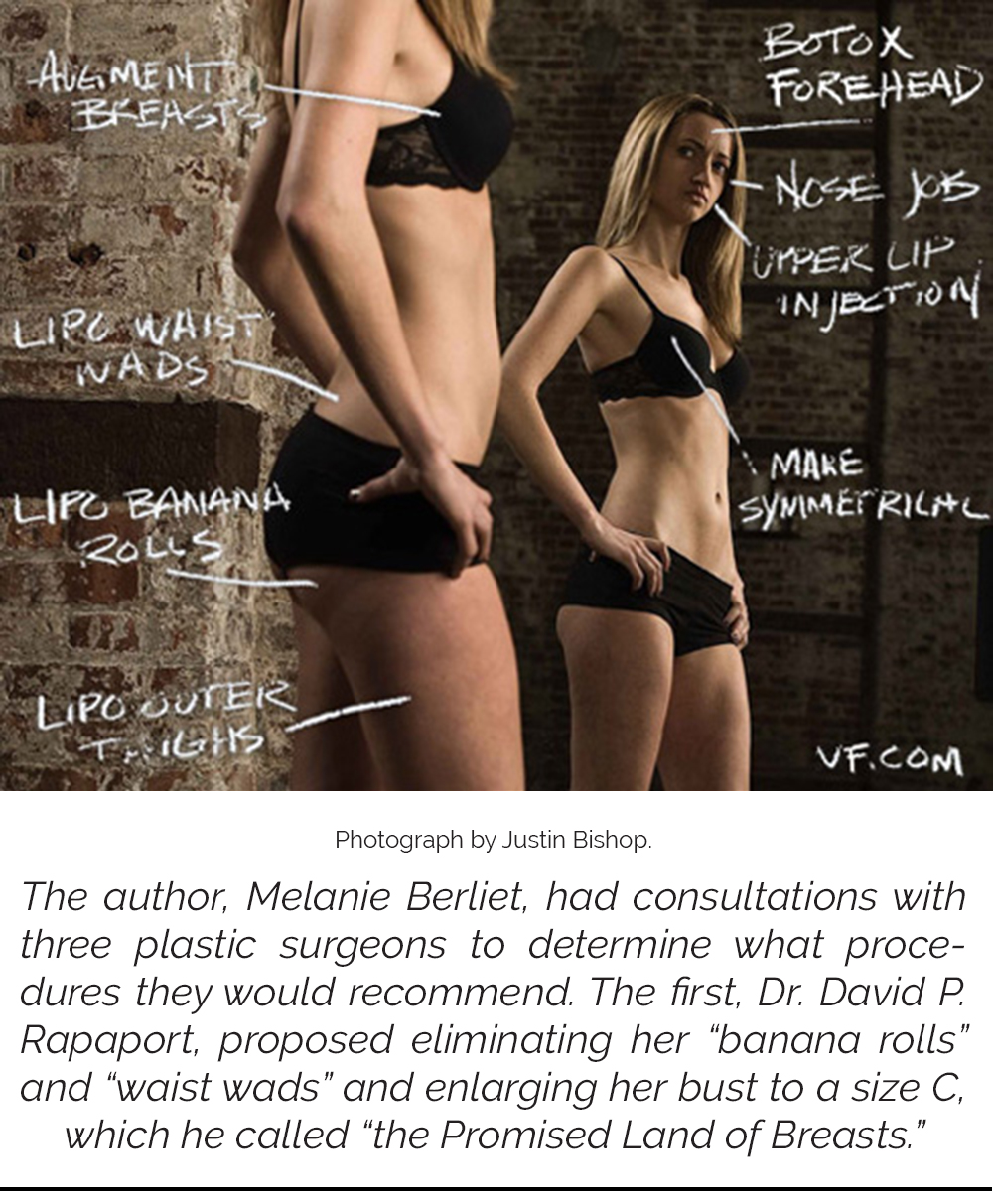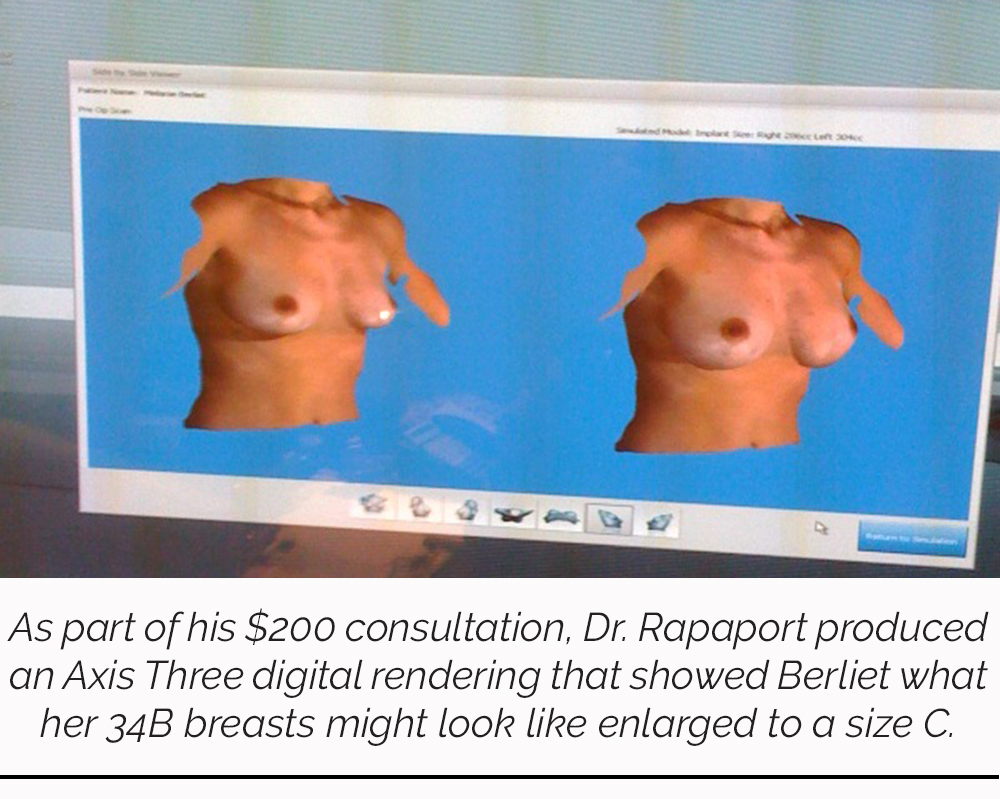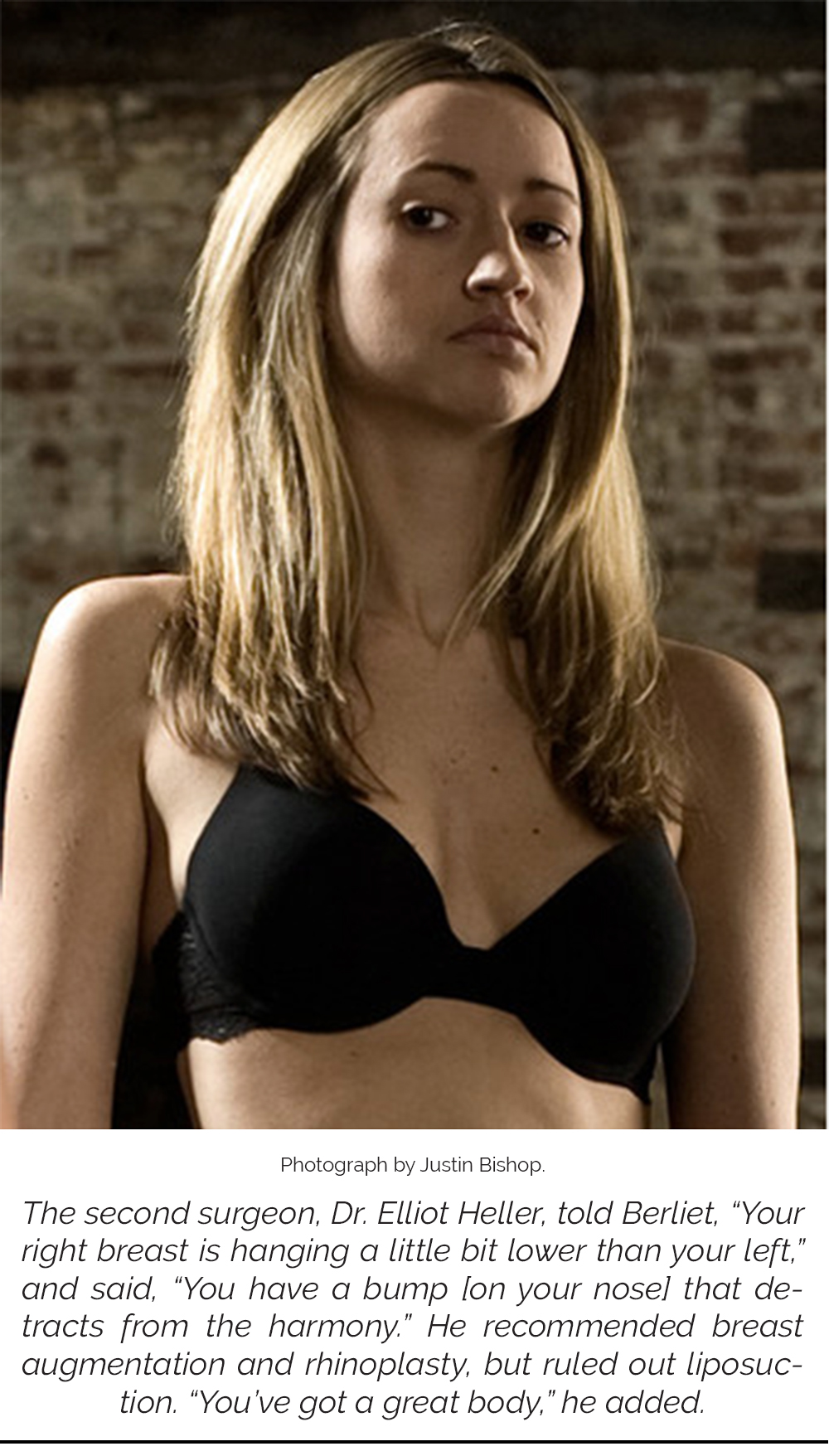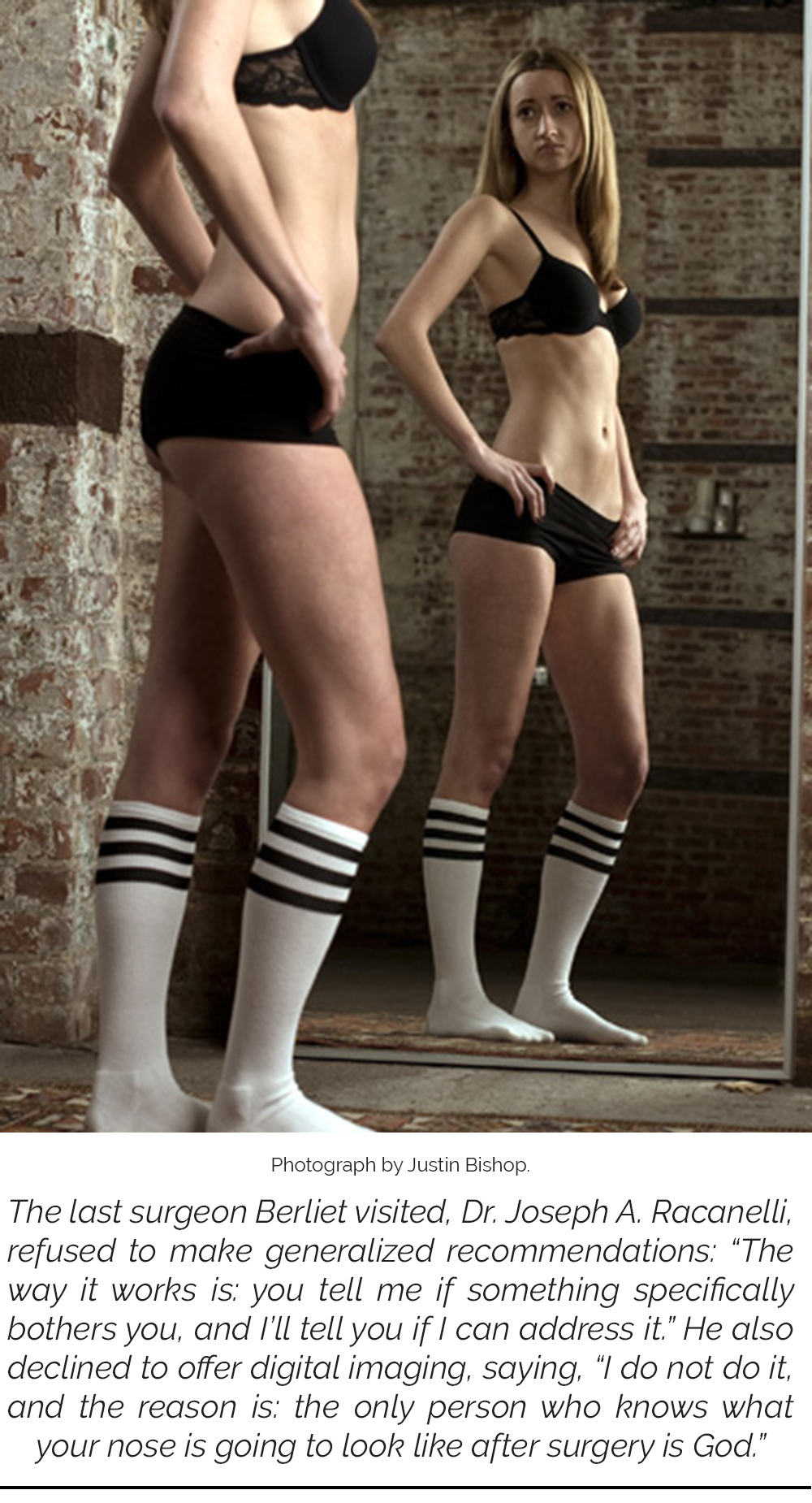

With a swoop of his well-manicured fingers, Dr. David P. Rapaport lifts the lining of my black Calvin Klein underwear—and gives me a wedgie worthy of a grade-school bully. With nothing left to shield my naked flesh from his discerning eyes, I stand in the unforgiving light wondering what the hell I was thinking when I decided to come here.
 My mission within this sterile examination room is simple enough: to catch an up-close-and-personal glimpse of a multi-billion-dollar industry. This is my first stop in a series of three consultations with plastic surgeons at various price points. I plan to give each one free rein over my face and body, to discover how far each will go in urging me to alter my objectively healthy, 27-year-old, five-foot-nine-inch, 120-pound figure. Alongside me is a Vanity Fair staffer appointed to pose as my boyfriend while secretly recording the sessions.
My mission within this sterile examination room is simple enough: to catch an up-close-and-personal glimpse of a multi-billion-dollar industry. This is my first stop in a series of three consultations with plastic surgeons at various price points. I plan to give each one free rein over my face and body, to discover how far each will go in urging me to alter my objectively healthy, 27-year-old, five-foot-nine-inch, 120-pound figure. Alongside me is a Vanity Fair staffer appointed to pose as my boyfriend while secretly recording the sessions.
Dr. Rapaport, who charges $200 for a consultation, received his M.D. from Tel Aviv University in 1985, trained at the N.Y.U. Institute of Reconstructive Plastic Surgery, and made New York magazine’s 2003 list of the city’s best cosmetic surgeons. His Fifth Avenue offices are lavish, with pristine walls and plush carpeting. My companions in the luxe waiting room include a stunning, Prada-clad Asian woman and multiple photo albums showcasing before and after shots for various nips and tucks.
Now the doctor and I stand in front of the floor-length mirror while he deconstructs the “before” me. “As a Caucasian woman, you probably—if you were doing lipo—would want this brought down,” he says, pointing to my “banana rolls”—his clever name for the part of my rear end that peeks from beneath my underwear lining. “And again, you know, in jeans, to most people … on white women, you guys like to get this down. And we like to see it down.” I gulp, realizing that I’ll never be able to eat my favorite fruit again without thinking of my own ass.
I’ve always thought of plastic surgery as a wealthy, distant relative—one I don’t want to know now, but on whom I might have to rely someday. To avoid dooming myself to a choice between hypocrisy and wrinkled skin, therefore, I’ve refrained from condemning it altogether. Still, it’s hard not to disapprove of what its rise has wrought: the expressionless faces, the cartoonish body parts, the celebrities who look like they’re wearing masks of their former selves.
The roots of plastic surgery are certainly honorable enough. The term derives from the ancient-Greek word plastikos, meaning “to mold.” The earliest recorded examples date back to 600 B.C., when the Hindu surgeon Sushruta developed techniques for repairing mutilated faces. It was not until the mid-19th century that the aspirations of plastic surgeons swayed markedly toward superficial ends, when anesthesia became more widely available. New techniques were developed in the mid-20th century, in response to the needs of wounded veterans from World Wars I and II, but even then the emphasis remained on healing, not on enhancing.
Fast-forward to the present. In 2007 alone, Americans spent $13 billion on 11.7 million cosmetic procedures (both surgical and nonsurgical). An ongoing controversy over what qualifies as “cosmetic” makes it difficult to determine the number of treatments that were purely restorative, necessitated by third-degree burns, mastectomies, and other medical issues. But what’s clear is that the overall number of men and women undergoing cosmetic procedures in the U.S. has increased by 457 percent since 1997, when relevant statistical data was first collected. As many as one in 20 people today reportedly suffer from Body Dysmorphic Disorder (B.D.D.), a sort of “imagined ugly” syndrome. While difficult to diagnose, plastic-surgery addiction is often linked to B.D.D. Dr. Barry Eppley, who writes a blog titled “Explore Plastic Surgery,” estimates that one-third of plastic-surgery patients will eventually return to have additional work done.
As elective plastic surgery becomes more prevalent, it’s becoming acceptable at younger and younger ages—or so it seems. The data suggests that the percentage of patients aged 19–34 has hovered close to 20 percent over the past few years, and that the proportion under age 18 has remained near 2 percent. But there’s no escaping the example of young celebrities such as Britney Spears, Lindsay Lohan, and Blake Lively—all rumored to have gone under the knife before their 21st birthdays. Is cosmetic surgery becoming a shortcut to self-esteem for people who are too young to know better?
When I began this project, I was relatively certain that I didn’t need plastic surgery. I also suspected that plastic surgeons might tell me otherwise. To test my hypothesis, I went undercover. In the process, I hoped to learn something about what happens inside examination rooms across New York City and, by extension, the United States. Are teenybopper idols and those who emulate them freely choosing plastic surgery? Or is plastic surgery choosing them?
Back in the Upper East Side exam room, Dr. Rapaport pinches me from shoulders to knees before concluding: “You look absolutely nice, but, even if I were a blind guy and put my hands here”—he seizes my sides—“there are little lumps. This could be brought down just to give you a little bit better of a curve.” These lumps, I learn, are my “waist wads.” To his credit, Dr. Rapaport does note that my “waist wads” are “borderline.” But, he says, “I’ve done supermodels with much less than this. To them it was important. To each his own.”
Having reviewed my figure to his satisfaction, Dr. Rapaport recommends liposuction on my outer thighs, love handles, and banana rolls, which will set me back about $8,000. He also raises the possibility of sucking the fat from my inner knees but does say after more pinching that they’re actually “quite empty.”
The good news is that the lipo can be done at the same time as my breast augmentation. The doctor boasts that he is one of few in possession of an Axis Three visualization system, a state-of-the-art digital-imaging program that can display the 3-D outcome of my boob job in the next room—but only after
he finishes with me here.
“You’re a 34B, and you want to be aaaaa … ”
“Nothing outrageous. Something tasteful,” I suggest.
He prefaces his conclusion with a hypothetical scenario: “I think if I were a single plastic surgeon, which I’m not, riding around in my Corvette, which I don’t, my license plate would read full c. O.K.? That would be my license plate. So that’s what I would think, in general, is the Promised Land of Breasts for most people.”
There’s something else: “Your breasts are definitely asymmetric. They’re not bad.”
Ultimately, Dr. Rapaport suggests silicone implants—one slightly bigger, for my dwarfed left breast—to bring me to a full C or a small D-cup. The cost for these is $13,000.
“Do you want me to talk about your face?”
No, I don’t wish to invite further blows to my ego. But what comes out of my mouth is: “Yes, I do.”
This is the part I feared the most. I still can’t shake the scarring memory of an elementary-school classmate asking me if I’d chosen to be a wizard for Halloween because the long, pointy hat made my long, pointy nose look smaller.
Nevertheless, I oblige Dr. Rapaport’s request to look with him into a small round mirror. He begins with a compliment—“You’re very smooth”—then tells me I could inject Botox ($500 for a dose lasting four months) into my forehead to control the “disproportion in animation” there. My overlip is a bit “retruded” or “retracted,” but an injection of Restylane (about the same price and duration as the Botox) will bring it forward. He also points to my chicken-pox scars, moles, and freckles—all candidates for fixing.
“Then, if we pull out the knife, the only thing that I’d really consider on you is this guy,” he says, tapping at his own enviably slender snout. “A very nice reduction rhinoplasty,” at a cost of $11,000, will take my bump down.
In total, Dr. Rapaport proposes roughly $33,000 worth of plastic surgery. By this time my self-image is so battered that, had I the money, I sincerely doubt I could refuse.
 The only remaining point on the doctor’s agenda is the 3-D imaging of my breasts. Before we go next door, he looks me over and offers one last piece of advice: “I’d play with your hair, actually.”
The only remaining point on the doctor’s agenda is the 3-D imaging of my breasts. Before we go next door, he looks me over and offers one last piece of advice: “I’d play with your hair, actually.”
“Really?,” I ask. “What would you do with my hair?”
“I might lighten it. I’d send you to a hair guy. If I were gay, I might have all the answers.”
In the following days, I regroup by shoving Dr. Rapaport’s appraisal of my appearance into the place where I store the last shreds of my Catholic guilt and knowledge of how to do long division. I’d be lying, though, if I said that I didn’t look in the mirror more often, with more judgmental eyes. Or that I didn’t dread round two.
“I’ll show you if you like,” says Maria, the svelte, well-dressed 42-year-old manager of Dr. Elliot Heller’s office, when I ask if she’s had her boobs done.
I nod and, without hesitation, Maria approaches me from behind the dark wooden desk, beige cowl-neck sweater peeled from her torso to reveal two perky, C-cup breasts.
“Can I touch?,” I ask, inspired by acute curiosity.
“Go ahead.”
 I stand and place a palm on Maria’s left breast, then poke it the way a child would a large block of jell-o. It feels not like human flesh, but like a compressed sack of the pink ectoplasm from Ghostbusters II resting behind a thin layer of skin. All the while, Maria gazes at me with a prideful expression. I have to admire her. Perhaps it’s more arrogant to deny one’s vanity than to embrace it.
I stand and place a palm on Maria’s left breast, then poke it the way a child would a large block of jell-o. It feels not like human flesh, but like a compressed sack of the pink ectoplasm from Ghostbusters II resting behind a thin layer of skin. All the while, Maria gazes at me with a prideful expression. I have to admire her. Perhaps it’s more arrogant to deny one’s vanity than to embrace it.
Dr. Heller trained in plastic surgery at Mount Sinai Medical Center in New York City. His office occupies a concrete building right off the highway in Edison, New Jersey, across from the local Heavenly Ham meat market. I discovered him through a site called plasticsurgeryportal.com, and his initial consultative service is free. When I called his number, I had to list some problem areas, so I mentioned my breasts and nose before explaining that I wanted to explore all options.
“All right, well, tell me about the breasts first,” Dr. Heller says gently. “Tell me what bothers you about the breasts.”
“I’m a 34B. Uh, I don’t know. I’m not sure. I’d like to be proportional.”
Dr. Heller assures me that breast augmentation is a “wonderful procedure.” Then he says, “Most Americans want to be Cs. The Ds want to be Cs, and the Bs want to be Cs.”
Put this way, the assertion seems fair. And when Dr. Heller instructs me to lift up my shirt and bra, he manages to do so without making me feel like a lab animal.
“O.K., you’re a B,” he says. “Your right breast is hanging a little bit lower than your left. Everybody’s different. Can’t help that. You look great. O.K., put your bra down. You’ve got a great body.”
That was easy.
A beat passes before Dr. Heller moves on to the possibility of rhinoplasty. “O.K., now talk to me about the nose. Tell me what you don’t like about your nose.”
“Well, it looks like I broke it.”
“You don’t have a bad nose. I mean, you have a pretty face. You have a bump that detracts from the harmony,” he says.
Another fair point. “What else would you suggest?,” I ask, half afraid that Dr. Heller will attack my banana rolls.
“Like Botox? You don’t need it. You look good,” the doctor declares.
I ask if I should consider a lip injection.
“The lips, a lot of people like that. Some people put the Restylane in.” But he explains that Restylane doesn’t last, because the body metabolizes it. Then he compliments me again: “Your face is very attractive.”
“How about lipo?,” I try.
“You don’t need lipo.”
Perhaps tiring of my queries, the doctor tosses an implant across the desk and asks me to stuff it in my shirt. I humor him, and he asks, “How do you feel about that?”
I tell him it feels good, but that’s a lie. The protrusion of the jellyfish-like sack makes me feel like a 13-year-old girl with her training bra stuffed. I imagine myself on a conveyor belt, alongside Holly Madison, Heidi Montag, and the 400,000 or so women who undergo breast augmentation in an average year. I don’t feel more mature, or more beautiful. I feel silly.
In closing, Dr. Heller asks me to grab a pamphlet detailing financing opportunities. Silicone breasts will cost me $6,800, and my nose job will run $5,500. He adds that he can provide 3-D imaging of my nose if I e-mail him pictures. I assure him that I’ll be in touch and thank him—for restoring my sense of self, however inadvertently, more than for his time.
 The following Thursday, I enter a modest brick elevator building deep in Brooklyn for my third and final appointment. My attitude toward plastic surgery has already evolved from ambivalence to distaste, by way of awe, bitterness, and excessive familiarity. I wonder where this meeting will land me next.
The following Thursday, I enter a modest brick elevator building deep in Brooklyn for my third and final appointment. My attitude toward plastic surgery has already evolved from ambivalence to distaste, by way of awe, bitterness, and excessive familiarity. I wonder where this meeting will land me next.
The stack of aluminum business cards resting atop a glass desk doesn’t bode well. Dr. Joseph A. Racanelli saunters in and takes his seat. He’s a muscular man with spiky, gelled hair and a degree from the Lake Erie College of Osteopathic Medicine. I can’t say I’m surprised to see him gripping a protein shake in his right hand.
He goes through the standard health questions, then asks, “How can I help you today?”
“I was just hoping to get a professional opinion about my options in terms of plastic surgery.”
The doctor squints and replies, rather emphatically, “The way it works is: you tell me if something specifically bothers you, and I’ll tell you if I can address it. But I’m not here to sell you services or goods, because there may be something that you don’t see that I see.”
“And you won’t share?,” I ask, somewhat startled.
Dr. Racanelli explains that he has an ethical problem with pointing things out, because he’s heard of cases in which patients felt they were talked into a procedure. He continues, “If there’s a specific area of concern, then you and I can discuss it at length … I’m not here to, like, pitch you.”
“Is it a legal problem?,” I ask.
“No. Not a legal problem. It’s just the way I like to do things.”
In that case, I tell him, I’d like to talk about my nose and boobs.
Satisfied, the doctor proceeds. Most of what he says is familiar. He says I’m tall enough to carry a full C-cup, and observes that my nose has a “dorsal hump” and a “bulbous tip.”
“Is there a way to image what it might look like?”
“There’s a way to image, and it’s a very successful marketing tool,” he replies. “I do not do it, and the reason is: the only person who knows what your nose is going to look like after surgery is God.” Despite my general discomfort with superfluous references to a higher power, I feel the urge to jump out of my seat and give Dr. Racanelli a standing ovation.
He eventually leads me to an examination room, instructs me to undress, and leaves. He returns for the inspection, accompanied by a female nurse. After looking me over, he declares, “A full C would look great on you.”
Then I ask him about liposuction. “No. Definitely not. You do not need lipo,” he says, letting out a chuckle that I wish I could bottle and fling in Dr. Rapaport’s face.
Back in the office, I ask Dr. Racanelli, who is 35, what cosmetic procedures he’s had done himself. The answer: a nose job at age 15, two hair transplants, and Botox injections in his forehead. “I believe in cosmetic surgery,” he concludes, smiling.
Dr. Racanelli’s enthusiasm is infectious, but I don’t feel pressured by him. I pay the $100 consultation fee and receive a statement detailing the initial quote for breast and nose surgery: $17,500.
All three of the doctors I met during my foray into the realm of plastic surgery left a lasting impression on me. Dr. Rapaport unwittingly dismantled my self-esteem, Dr. Heller patched it back up, and Dr. Racanelli reminded me that how I look should be my choice. As for plastic surgery itself, I can’t say that I’m against it. For every Tara Reid, there must be 20 Marias or Dr. Racanellis, whose lives have been quietly enriched by procedures that made them look a little more perfect—if only in their own eyes.
That said, I’ve decided (for now) to hold on to the genetic hand I was dealt. Partly, I can’t afford to make Melanie 2.0 a reality; partly, I’m haunted by the classic Twilight Zone episode in which people select their appearance from menus upon coming of age; and partly—no, largely—I need to believe in the character-building powers of the flaws that make me me.
Call me stupid, stubborn, or ugly. Just don’t pinch my waist wads.
Mélanie Berliet is a writer living in New York City.